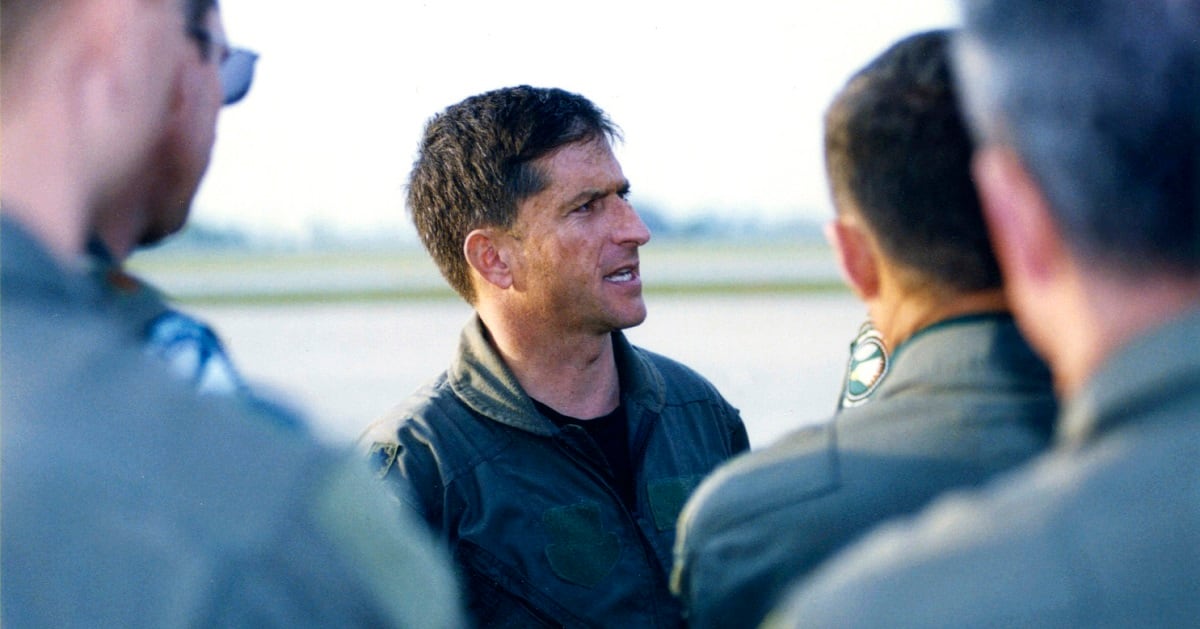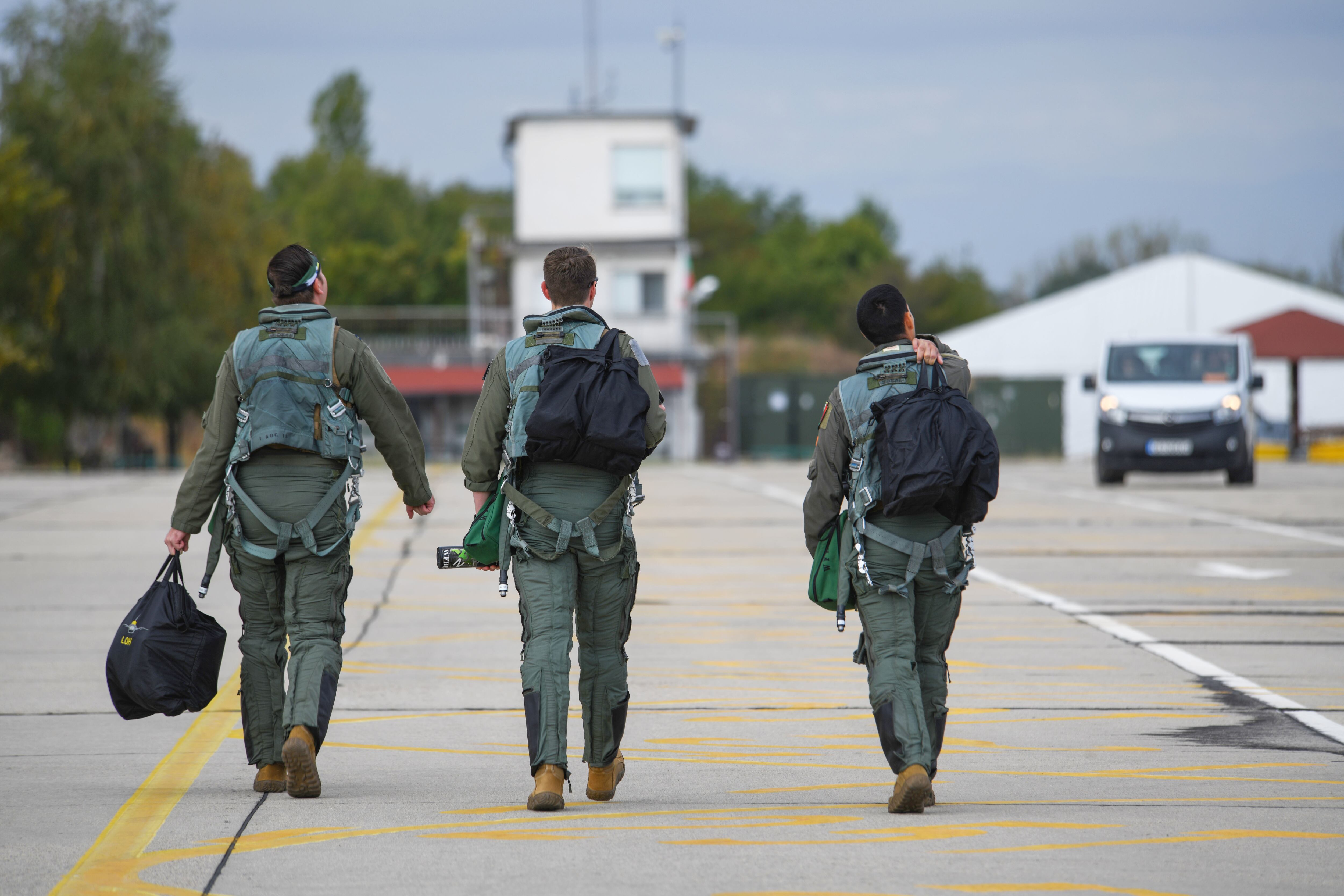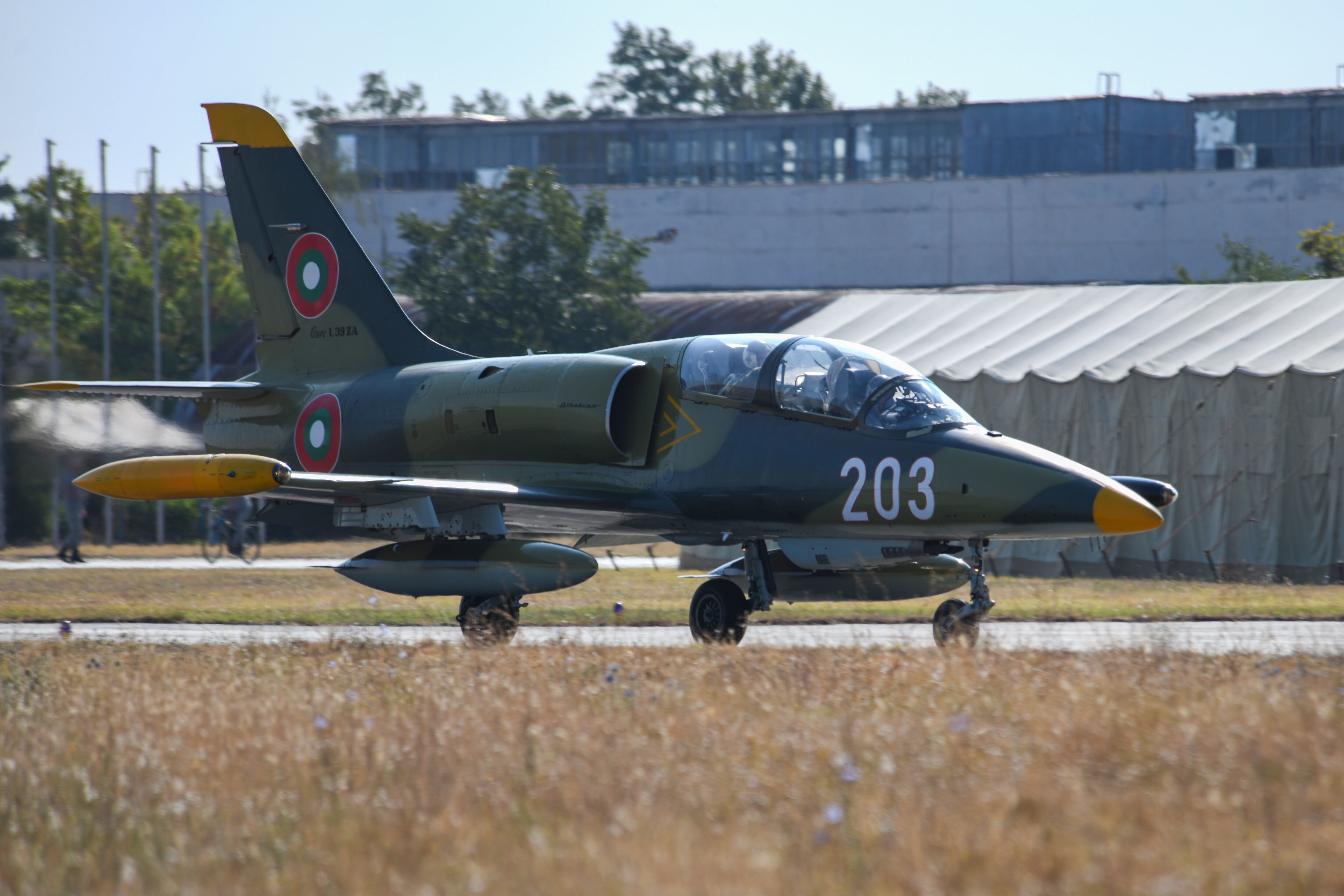At first glance, it would seem like the worst fears of the Cold War had come true: Air Force F-16s going toe-to-toe with Soviet-era MiG-29 fighters in the skies over Eastern Europe, trying to land a shot on one another.
But this week, these mock dogfights were a sign of the Air Force’s effort to strengthen its partnerships with the Bulgarian military and other NATO allies — and get its pilots some crucial training in air combat.
The exercise, called Thracian Viper, brought six F-16CMs and 13 pilots from the 555th Fighter Squadron — the “Triple Nickel” from the 31st Fighter Wing at Aviano Air Base in Italy — to Graf Ignatievo Air Base in Bulgaria, as well as 150 additional airmen from Aviano and other airmen from Ramstein Air Base in Germany. They began arriving Sept. 18, and the exercise wrapped up Friday.
All week long, they flew against and alongside Bulgarian pilots flying MiG-29s and L-39s stationed at Graf Ignatievo. F-16 and MiG-21 fighters from Romania, and F-16s from Greece also flew in from their own bases to take part in the exercise each day.
In a Thursday interview, Maj. Rohan Naldrett-Jays, an instructor pilot with the 555th, said that he and his fellow pilots felt fortunate to have the chance to square off against the kind of fighters flown by the Soviet Union.
“It was super cool,” said Naldrett-Jays, whose call sign is SWAT. “There are very few fighter pilots in the U.S. Air Force who have had the opportunity to fight Soviet fighters. We feel super lucky that we actually get to interact with the MiG-29s and get to fight with these guys.”

And the dogfights didn’t always end in a U.S. Air Force rout, Naldrett-Jays admitted. There were a few instances where the Bulgarian fighters ended up getting the drop on the American F-16s — which caused the Air Force pilots to go back and try to figure out where they made mistakes, and look for ways to improve.
“We’re basically taking the handcuffs off, and we’re saying, ‘Hey, give us the best tactics that you operate on, on a day-to-day basis, and we’ll do what we do on an everyday basis,’” Naldrett-Jays said. “So instead of back home, where we’re simulating an adversary, we’re just telling them, ‘Hey, go for it,’ and we’ll see how challenging it is for the other country to prevail.”
Each jet flew twice a day, which meant every pilot got to fly at least four times this week — a little more frequently than a squadron’s usual pace.
Aviano also brought plenty of maintainers, as well as security forces, logistics and fuels airmen, Naldrett-Jays said. Ramstein provided combat communications airmen to set up classified computer networks at the Bulgarian base.
RELATED

The exercise involved not just air-to-air training, but the fighters also practiced air-to-ground missions — both as attackers and defenders — and how to protect combat search-and-rescue aircraft and personnel trying to rescue forces in danger on the ground, Naldrett-Jays said.
The days began with the American and Bulgarian fighters meeting in a briefing room to coordinate, including sorting out how to deconflict from one another in the air, how they would communicate — particularly important with the language barriers that existed — and the tactics they would practice that day.
On Wednesday, for example, the American F-16s set up a combat air patrol, orbiting in the flight area about 20 miles north of Graf Ignatievo and practiced using their sensors to detect the Bulgarian MiGs. There were four F-16s against two Bulgarian jets, Naldrett-Jays said, and they split up into two-on-one fights.

Once the F-16s spotted the Bulgarian jets — the MiGs, with their “big smoky engines,” were easier to visually identify from a distance, Naldrett-Jays said — they then left those orbits to intercept them.
The F-16s tried to sneak up behind the Bulgarians, he said. But when the Bulgarians saw the American pilots, the (mock) fight was on.
Each pilot had symbols in their heads-up displays that show where the simulated shots they take at their opponents went, and track when they scored a hit. The F-16s flew about an hour and 20 minutes Wednesday, he said, and the Bulgarians flew 30 or 40 minutes. Each of the four engagements that day took about a minute or two.
Naldrett-Jays said that this was an ideal opportunity to practice fighting within visual range, mostly using cannons in a scenario where the pilots have already shot off all their missiles. Fighting with missiles, beyond visual range, can easily be practiced in simulations at home, he said. So when time and gas is limited for these kinds of flights, it’s most efficient to use it primarily practicing dogfighting.
“Being able to actually see a MiG-29 up close, and maneuver in relation to it, that’s something we obviously don’t get the opportunity to do very often,” Naldrett-Jays said.
During the first three sets on Wednesday, he said, the American F-16s were able to sneak up on the Bulgarians. But the last time, Naldrett-Jays and his wingman tried something different, and the Bulgarians seized the opportunity to take their shots.
The Americans didn’t even realize they had been scored on until the post-flight debriefing, when their Bulgarian counterparts surprised them with the news that they had shot the F-16s.
“The U.S. guys in the room looked at each other and said, ‘Ah, crap, what did we do?’” Naldrett-Jays said.

The Bulgarians pulled up the video of their HUD footage and sure enough, there were the shots — some cannon shots recorded on Naldrett-Jays, and a clear missile shot on his wingman. Naldrett-Jays chuckled and said the Bulgarian got a “couple lucky shots” on him.
“No matter where you are in the world, being a fighter pilot is kind of the same thing,” Naldrett-Jays said. “Everybody wants to win really hard. Watching those guys be really proud of, ‘Oh yeah, we got this F-16 in our HUD with a valid missile shot against it.’ … At the end of the day, we all had a good laugh about it.”
But it was also a humbling learning opportunity.
“We definitely took that back to our debrief,” Naldrett-Jays said. He and his wingman discussed “what his [one-on-one] maneuvering gameplan was, what he did incorrectly, what he can do better next time.”
Despite the precautions required by the COVID-19 pandemic, the U.S. and Bulgarian airmen interacted each day and got to know each other a little better, Naldrett-Jays said. They learned more about how the Bulgarian jets operate, how they run their squadrons and how they train, he said.
The pilots traded patches with one another, and shared war stories over lunches — eaten at picnic areas outdoors, to limit the spread of coronavirus.
Thracian Viper also had some exercises where fighters from different nations practice fighting alongside one another. Naldrett-Jays said that the exercise planned for Friday called for a pair of Romanian fighters to team up with two American F-16s and defend a target area on the ground, against two other U.S. F-16s who were acting as the aggressors and trying to destroy that ground target.
Naldrett-Jays said that for pilots, portraying the “red air” adversary at home gets kind of boring, because you know everything your opponent is capable of. But in Bulgaria, those pilots got to face aircraft they were unfamiliar with, which gave them fresh and varied experiences.
“It’s really cool to watch the NATO partnership out here,” Naldrett-Jays said. “It’s seeing how their tactics differ from ours. Maybe we can go back to the drawing board and go, ‘Hey, these guys did this really well, why were they so successful?’”
And on Thursday, the fighters took part in a CSAR training exercise. The U.S. F-16s integrated with Mi-17 and Mi-24 helicopters and MiG-29s and practiced protecting the rescue forces during their most vulnerable period, when they go in to rescue the endangered personnel.
The fighters also practiced evading a Bulgarian SA-6 surface-to-air missile site as part of the air-to-ground exercises. The SA-6 would go through its engagement sequence and lock its radar on the F-16s, he said. The pilots then got a warning that a mock missile had been launched against them, which they would have to evade.
The Triple Nickel makes sure its pilots know how important such training is. Naldrett-Jays said that the squadron shows its pilots the HUD footage from when former Chief of Staff Gen. Dave Goldfein, when he commanded the 555th, was shot down by a Serbian SAM battery in 1999.
“It’s definitely a conversation we have very often, especially with the young guys,” he said. “The young guys are the ones that need to hear that these things and this training is going to be what saves your life.”
Stephen Losey is the air warfare reporter for Defense News. He previously covered leadership and personnel issues at Air Force Times, and the Pentagon, special operations and air warfare at Military.com. He has traveled to the Middle East to cover U.S. Air Force operations.




